The Bridge on the River Kwai facts for kids
Quick facts for kids The Bridge on the River Kwai |
|
|---|---|
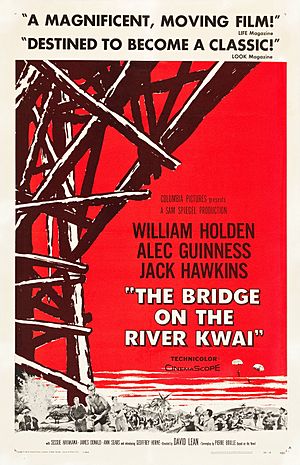
American theatrical release poster, "Style A"
|
|
| Directed by | David Lean |
| Produced by | Sam Spiegel |
| Screenplay by |
|
| Starring |
|
| Music by | Malcolm Arnold |
| Cinematography | Jack Hildyard |
| Editing by | Peter Taylor |
| Studio | Columbia Pictures Horizon Pictures |
| Distributed by | Columbia Pictures |
| Release date(s) | 2 October 1957 (London-premiere) 11 October 1957 (United Kingdom) 14 December 1957 (United States) |
| Running time | 161 minutes |
| Country | United Kingdom United States |
| Language | English Japanese |
| Budget | $2.8 million (equivalent to $31 million in 2024) |
| Money made | $30.6 million (equivalent to $343 million in 2024) |
The Bridge on the River Kwai is a famous war film from 1957. It was directed by David Lean and is based on a novel by Pierre Boulle. The story in the film and book is mostly made up. However, it takes place during a real historical event: the building of the Burma Railway in 1942–1943.
The movie stars well-known actors like William Holden, Alec Guinness, Jack Hawkins, and Sessue Hayakawa. The original writers, Carl Foreman and Michael Wilson, had to work in secret. This was because they were on the Hollywood blacklist, which meant they were not allowed to work openly in the American film industry. For a long time, Pierre Boulle, who didn't speak English, received the Academy Award for Best Adapted Screenplay. Years later, Foreman and Wilson were given the award they deserved.
The Bridge on the River Kwai is considered one of the greatest films ever made. It earned the most money in 1957 and received excellent reviews. The film won seven Academy Awards, including Best Picture. In 1997, the United States Library of Congress chose it for preservation in the National Film Registry. This means it was seen as "culturally, historically, or aesthetically significant."
Contents
About the Film
Story of the Film
The movie begins in February 1943 at a Japanese prison camp in Thailand. A group of British prisoners of war, led by Colonel Nicholson, arrive. United States Navy Commander Shears tells Nicholson that the camp conditions are very harsh. Nicholson tells his men not to try to escape. He believes it's impossible due to the thick jungle.
Colonel Saito, the camp leader, tells the prisoners they must build a railway bridge. This bridge will cross the River Kwai and connect Thailand and Burma. Nicholson argues that the Geneva Convention says officers don't have to do manual labor. Saito threatens the officers, but Major Clipton, the British doctor, warns him about witnesses. The officers are made to stand in the hot sun all day. Later, Saito punishes Nicholson severely and confines him.
Shears and three other prisoners try to escape. Only Shears makes it out alive. He is wounded but finds help in a Thai village. After recovering, he ends up in Ceylon.
The bridge building goes poorly because of the Japanese engineers' mistakes and the prisoners' slow work. Saito tells Nicholson that if the bridge isn't finished on time, he will face a very serious traditional consequence. Nicholson is shocked by how badly his men have built the bridge. He decides to take charge and build a proper, strong bridge. He sees it as a way to show the British Army's skill. But Clipton thinks this is like working with the enemy. Nicholson becomes obsessed and even volunteers his officers to help.
Meanwhile, Major Warden tries to get Shears to join a secret mission to destroy the bridge. Shears refuses, admitting he pretended to be an officer for better treatment. Warden tells him they already knew and that he has no choice but to join the mission. Warden, Shears, and two others, Chapman and Joyce, parachute into Thailand. Chapman dies during landing. Warden is hurt in a fight with a Japanese patrol. A village chief, Khun Yai, and some Thai women help the group reach the river.
Under the cover of darkness, Shears and Joyce place explosives at the base of the bridge. The first train is set to cross the next day. Warden wants to destroy both the train and the bridge. But by morning, the river level drops, showing the wire connected to the detonator.
Nicholson sees the wire and investigates with Saito as the train approaches. Nicholson pulls up the wire, leading them to Joyce, who is ready to detonate. Joyce attacks Saito. Nicholson tries to stop Joyce from reaching the detonator. After Joyce is shot, Shears swims to the detonator but is also fatally wounded. Nicholson recognizes Shears and realizes what he has done. Warden fires a mortar, wounding Nicholson. Dazed, Nicholson falls onto the detonator, blowing up the bridge. The train crashes into the river. Warden tells his horrified guides, "I had to do it! They might have been taken alive!" Clipton, seeing the destruction, cries out, "Madness! ... Madness!"
Main Characters
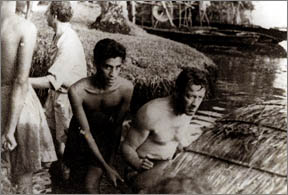
Here are some of the main actors and the characters they played:
- William Holden as "Commander" Shears, an American sailor who escapes.
- Jack Hawkins as Major Warden, a British commando.
- Alec Guinness as Colonel Nicholson, the British commander.
- Sessue Hayakawa as Colonel Saito, the Japanese camp commander.
- James Donald as Major Clipton, the British medical officer.
- Geoffrey Horne as Lieutenant Joyce, a commando.
Making the Film
The Script
The writers, Carl Foreman and Michael Wilson, faced a difficult situation in Hollywood. They were on a "blacklist," which meant they couldn't openly work in the American film industry. So, they worked on the script in secret while living in England. They didn't work together on the script; Wilson took over after the director, David Lean, wasn't happy with Foreman's work. The official credit for the screenplay went to Pierre Boulle, who didn't even speak English. He even won an Oscar for it! Years later, in 1984, the Academy corrected this. They gave the Oscar to Foreman and Wilson, after they had passed away.
The film is quite similar to the book, but with two big changes. In the book, Shears is a British officer, but in the movie, he's an American sailor who escapes. Also, in the book, the bridge isn't completely destroyed. The train falls, but the bridge only gets a little damaged. Pierre Boulle liked the movie, even though he didn't agree with the ending.
Choosing the Actors
Director David Lean first wanted Charles Laughton to play Nicholson, but Laughton was not able to film in a tropical place. Cary Grant was also offered the role but turned it down. Alec Guinness, who eventually played Nicholson, said that Lean "didn't particularly want me" for the part.
William Holden made a very good deal for the film. He received 10% of the money the film earned, which was a lot for an actor at that time.
Filming Locations and Challenges
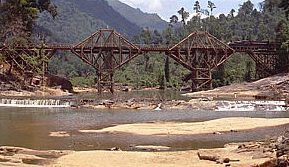
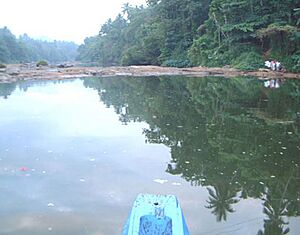
Many famous directors were considered for this movie, like John Ford and Howard Hawks. The film was a joint project between companies from the UK and the United States.
Director David Lean often had disagreements with his actors, especially Alec Guinness. Guinness wanted to play Colonel Nicholson with more humor, but Lean wanted him to be more serious. Once, Lean was so frustrated with the British actors that he said he was glad to start working with an American actor (William Holden) the next day.
The movie was filmed in Ceylon (now Sri Lanka). The famous bridge in the film was built near a place called Kitulgala. The Mount Lavinia Hotel was used for the hospital scenes.
Alec Guinness later shared that he based Nicholson's walk after coming out of a punishment hut on his young son, Matthew. His son was recovering from polio and was temporarily unable to move his legs well. Guinness felt this was his "finest piece of work."
David Lean himself almost drowned during filming when he was swept away by the river current.
The bridge explosion scene was a big event. It was filmed on March 10, 1957, with the Prime Minister of Ceylon, S.W.R.D. Bandaranaike, watching. The first attempt didn't work perfectly, but the bridge was repaired and successfully blown up the next morning.
Music of the Film
| The Bridge on the River Kwai (Original Soundtrack Recording) | |
|---|---|
| Soundtrack album by
Various
|
|
| Released | 1957 |
| Recorded | 21 October 1957 |
| Genre | Soundtrack |
| Length | 44:49 |
| Label | Columbia Records |
| Producer | Various |
| Review scores | |
|---|---|
| Source | Rating |
| AllMusic | |
| Discogs | |
British composer Malcolm Arnold had only ten days to write about 45 minutes of music for the film. He called it the "worst job I ever had" because of the tight deadline. Despite this, he won an Oscar and a Grammy for his work!
A very memorable part of the film is the tune the prisoners whistle when they enter the camp. It's the "Colonel Bogey March." This march was written in 1914 by Kenneth J. Alford. For the movie, Malcolm Arnold added his own "The River Kwai March" to go with it.
In many intense scenes, the film uses only the sounds of nature. For example, when commandos Warden and Joyce are chasing a Japanese soldier through the jungle, you only hear the sounds of the jungle, which makes the scene very suspenseful.
Is it a True Story?
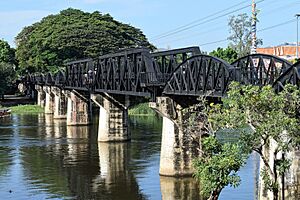
The story and characters in the film are mostly fictional. There are many differences between the movie and what really happened.
The conditions for the prisoners of war and other workers building the Burma Railway were much harder than shown in the film. Many people died during its construction. The Commonwealth War Graves Commission states that about 13,000 prisoners of war died. Also, an estimated 80,000 to 100,000 civilians died while working on the project.
The real senior Allied officer at the bridge was Lieutenant Colonel Philip Toosey. He was very different from the character of Nicholson. Toosey did not try to help the Japanese. In fact, he tried to slow down the construction. While Nicholson in the movie doesn't like sabotage, Toosey actually encouraged it. For example, they collected many termites to eat the wooden structures, and they mixed the concrete poorly. Some people felt the film made fun of the real Lt. Col. Toosey.
A former prisoner from the camp said that a real officer like Nicholson, who seemed to work with the enemy, would likely have been "quietly eliminated" by the other prisoners.
Julie Summers, in her book The Colonel of Tamarkan, writes that Pierre Boulle, who was a prisoner of war in Thailand, based Nicholson on French officers he remembered who cooperated with the enemy. Boulle said his book was not anti-British, but many people involved in the film, including Alec Guinness, felt it was.
Ernest Gordon, who survived the railway construction, wrote in his 1962 book, Through the Valley of the Kwai:
In Pierre Boulle's book The Bridge over the River Kwai and the film which was based on it, the impression was given that British officers not only took part in building the bridge willingly, but finished in record time to demonstrate to the enemy their superior efficiency. This was an entertaining story. But I am writing a factual account, and in justice to these men—living and dead—who worked on that bridge, I must make it clear that we never did so willingly. We worked at bayonet point and under bamboo lash, taking any risk to sabotage the operation whenever the opportunity arose.
Some Japanese viewers were not happy with how the movie showed their engineers. They felt it made them seem less skilled than they really were. Japanese engineers had been planning the railway since 1937 and were very skilled. Some also felt the film unfairly showed Allied prisoners as better at building the bridge than the Japanese engineers.
The main railway bridge in the story didn't actually cross the river then known as the Kwai. In 1943, a bridge was built by Allied prisoners over the Mae Klong river, which was later renamed Khwae Yai in the 1960s because of the film. Pierre Boulle had never been to the real bridge. He just assumed it crossed the Kwai. The destruction of the bridge in the film is also completely made up. In reality, two bridges were built: a temporary wooden one and a permanent steel one. Both were used for two years until Allied planes destroyed them. The steel bridge was repaired and is still used today.
Watching the Film at Home
First Time on TV
ABC paid a lot of money, $1.8 million, to show the film on television twice in the United States. The movie, which is 167 minutes long, was first shown without cuts on September 25, 1966. It was part of an ABC Movie Special and lasted over three hours because of commercials. It was unusual for a TV network to show such a long film in one evening back then. But it was a huge success for ABC, with a record audience of 72 million viewers!
Restoring the Film
In 1972, The Bridge on the River Kwai was one of the first movies released on the early Cartrivision video format.
The film was carefully restored in 1985 by Columbia Pictures. They found the original sound recordings for dialogue, music, and effects and mixed them again. The picture quality was also improved.
On November 2, 2010, Columbia Pictures released a newly restored version of the film on Blu-ray. They used a new 4K digital restoration from the original film negative. This means they scanned the film at a very high resolution, four times better than High Definition. They also fixed colors and removed dirt and scratches. The restoration team had to fix many old film problems, like torn frames and color fading. They even fixed unique issues from the original camera lens, like a "ghosting" effect and the image jumping slightly.
See also
 In Spanish: El puente sobre el río Kwai para niños
In Spanish: El puente sobre el río Kwai para niños
- BFI Top 100 British films
- List of American films of 1957
- List of historical drama films
- List of historical drama films of Asia
- To End All Wars (film)
- Return from the River Kwai (1989 film)
- Siam-Burma Death Railway (film)

